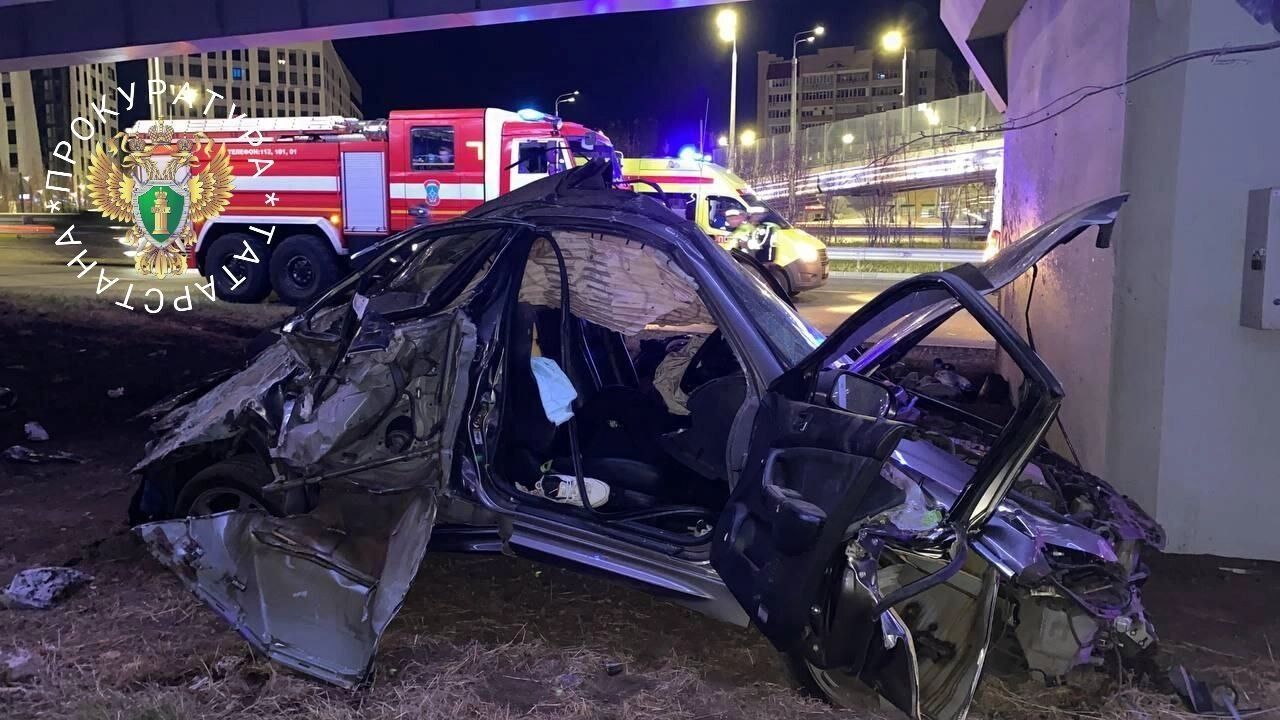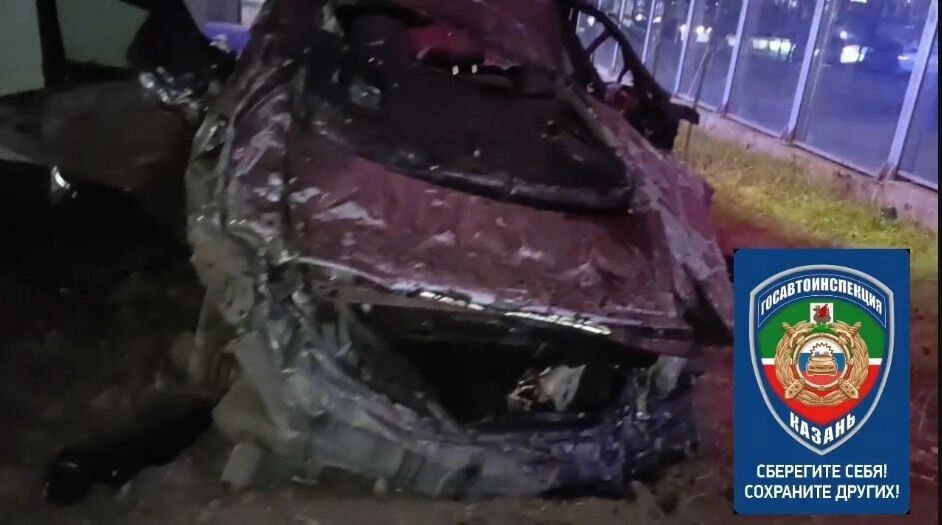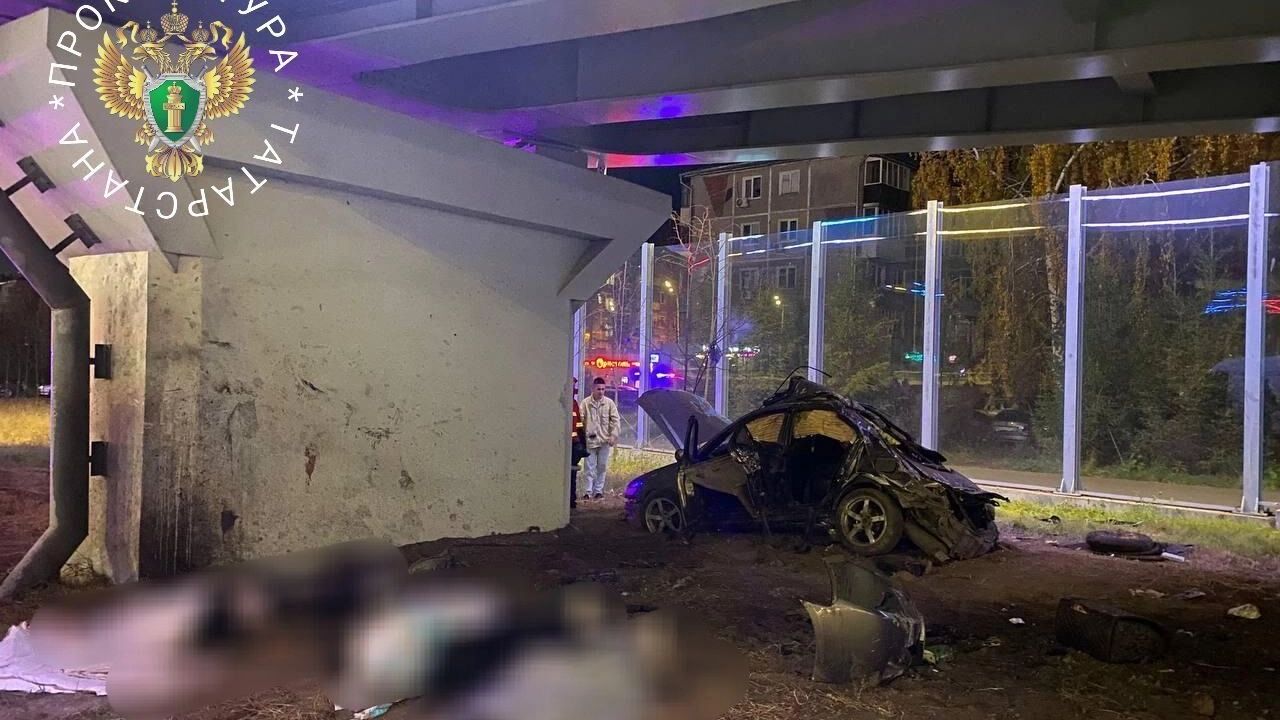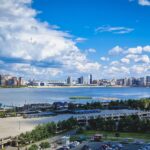A traffic accident on Gorky Highway in Kazan claimed the lives of three people. An inexperienced driver crashed into a pole. All passengers died at the scene. Local traffic police published disturbing footage of the incident.
Three Deaths at Once
The fatal accident occurred on Gorky Highway around 1:00 AM. The driver was a woman born in 2004 with only 6 months of driving experience. Reports indicate she was driving her friend’s car.
The vehicle was traveling from Mozhaysky Street toward Lazarev. According to traffic police, the car was moving at high speed when it first hit a lighting pole and then crashed into a concrete support pillar at the Gorky Highway-Vosstaniya interchange.
Three passengers died at the scene. The female driver, despite serious injuries, refused medical assistance.

A criminal case has been initiated for traffic violations resulting in the death of two or more persons through negligence. The investigation is being monitored by the Kazan city prosecutor’s office.
Deadly Highway?
The renovated Gorky Highway opened for traffic in late 2024. At that time, reconstruction was completed on an 11.5 km section from Musical Street to the M7 “Volga” highway.
Although the year is not yet over, several major accidents have already occurred on this expressway. In June of this year, a truck collided with a Lada Kalina, ramming it and crushing it against a guardrail. The truck then veered into the ditch on the opposite lane. The truck driver was urgently hospitalized.
The passengers of the car – a woman and a child – were injured in the accident. Both were taken to the hospital. According to traffic police, the truck driver lost consciousness at the wheel, which caused the accident.
During the summer, traffic police reported that speeding problems had intensified on Krasnokokshayskaya Street and Voznesensky Tract. Over 6 months, there were 143 accidents on the first road, 79 on the second, and 38 accidents on Voznesensky Tract.
To improve road safety, measures were proposed to increase the number of patrol vehicles in high-risk areas and deploy more portable speed cameras.
The Real Problem
In spring 2025, the speed limit on Gorky Highway was increased – vehicles can now travel up to 80 km/h. The Transport Committee stated this decision was due to improved road conditions. Previously, drivers could only reach 60 km/h.

Just a couple of months later, Kazan residents began requesting speed limits on the repaired roads. In municipal chats, citizens complained that after the repairs, truck and cargo vehicle drivers started “driving like crazy.”
Legal experts suggest that the expressways themselves are not to blame. The problem lies with the drivers.
“Expressways actually help people enter or exit the city faster. The real issue is that drivers break the rules. The only solution here is to install more cameras. The traffic flows are separated, but the main cause of head-on collisions is that we need better flow separation,” stated one legal expert.
Commenting on the recent accident, the expert noted that the driver’s experience level also played a role.
“Most
Gorky Highway
Gorky Highway is a major radial road in Moscow, Russia, leading from the city center towards the east. Historically named after the writer Maxim Gorky, it was developed as a key transport route and was famously the road taken by Soviet cosmonauts from the Kremlin to their residence in Star City. Today, it remains a vital and heavily trafficked artery connecting the capital to surrounding regions.Mozhaysky Street
Mozhaysky Street is a major thoroughfare in Saint Petersburg, Russia, named in 1952 after Alexander Mozhaysky, a pioneer in aeronautics who is credited with constructing one of the first full-size aircraft in Russia. The street has a rich history, having been known as Malaya Spasskaya Street in the 19th century before being renamed to honor the naval officer and inventor. Today, it is a significant transport artery running through several districts of the city.Lazarev
“Lazarev” most commonly refers to the Lazarev Institute of Oriental Languages in Moscow, a historic center for Oriental studies founded in 1815 by the Armenian Lazarev family. It was established to educate the children of the Armenian diaspora and later became a prominent institution for the study of Near Eastern and Asian languages and cultures. The institute’s historic building is an architectural landmark and now houses the Embassy of Armenia in Russia.Vosstaniya interchange
The Vosstaniya Interchange is a major traffic circle and metro station in the heart of St. Petersburg, Russia. It was constructed in the 1950s and named after the nearby Vosstaniya Square (Uprising Square), which itself commemorates the 1917 February Revolution. The area is a significant historical and transport hub, known for the iconic Moscow Railway Station and the towering Obelisk to the Hero City of Leningrad.Musical Street
Musical Street, or “La Calle de la Música,” is a unique cultural attraction located in Lima, Peru. Created in the 1990s, this residential street in the Barranco district is embedded with musical notes from a Peruvian waltz, allowing cars to produce a melody as they drive over it. It serves as a creative public art installation that celebrates local music and provides an interactive experience for both residents and visitors.M7 “Volga” highway
The M7 “Volga” highway is a major Russian federal highway connecting Moscow to the Ural Mountains, with its core route leading to the city of Kazan. Historically, the road follows ancient trade routes and was developed into a modern highway during the Soviet era. It serves as a vital transport link to the Volga River region and is a key corridor for travel and commerce.Krasnokokshayskaya Street
Krasnokokshayskaya Street is a central and historic thoroughfare in Yoshkar-Ola, the capital city of the Mari El Republic in Russia. The street’s name derives from the Mari name for the city, “Krasnokokshaysk,” which was used during the Soviet era. It is known for its mix of architectural styles and its role as a key commercial and cultural artery in the city.Voznesensky Tract
The Voznesensky Tract is a historic road in Siberia, Russia, originally established in the 18th century as a vital trade and postal route connecting Tomsk with the eastern regions. It played a significant role in the development and colonization of Siberia, facilitating the movement of people, goods, and ideas. Today, it is remembered as an important part of Russian history, though much of the original route has been superseded by modern highways.






